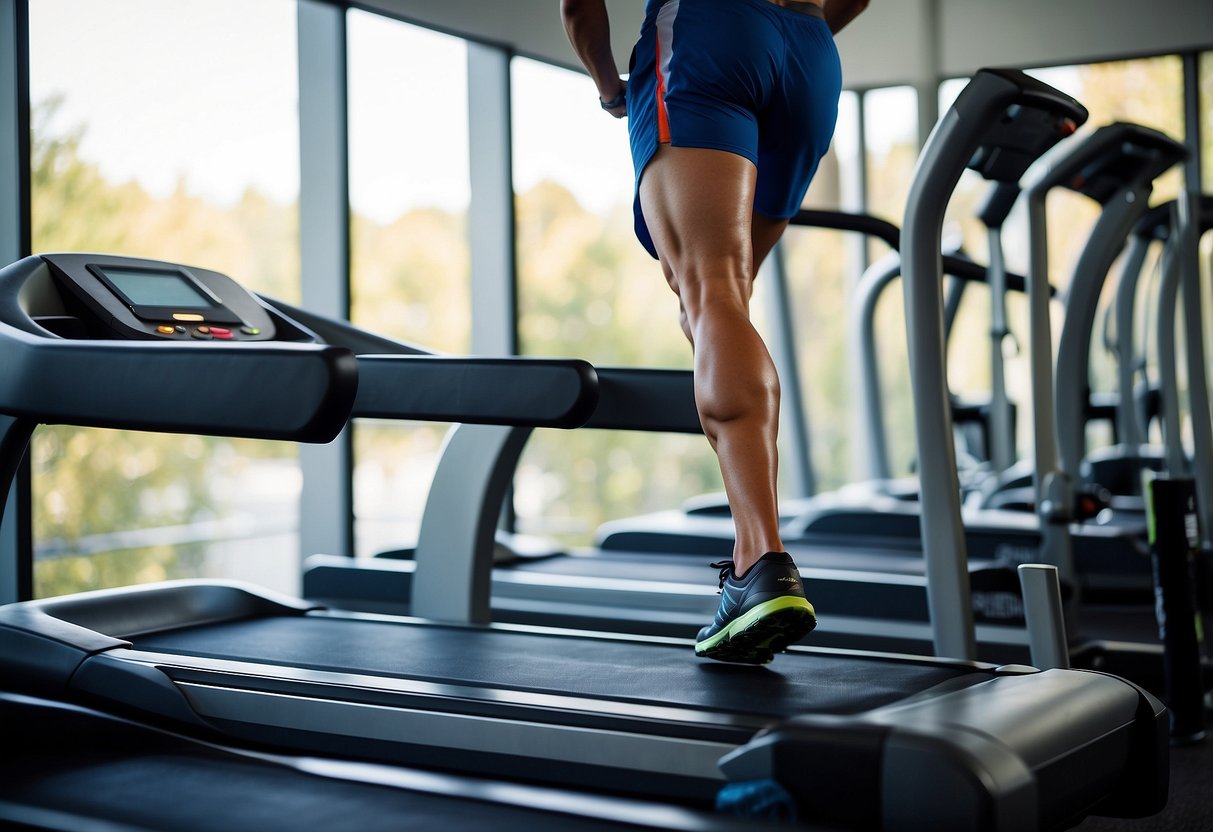Running on a treadmill can be a fantastic way to keep fit, whether you’re just starting out or you’re a seasoned runner. It’s a versatile piece of equipment that allows you to control your environment and pace, making it ideal for tailored workouts. Have you ever wondered how to make the most of your time on the treadmill?

Incorporating a variety of treadmill workouts into your routine can help target different fitness goals, from building endurance to burning calories. It’s about mixing it up and keeping things interesting to boost your motivation. By following these tips, you can transform your treadmill sessions into highly effective and enjoyable workouts.
Warm Up: Start Slow with a 5-Minute Walk
Before you jump into an intense treadmill workout, it’s essential to get your body ready. A great way to do this is by starting with a 5-minute walk. This gradual start helps prepare your cardiovascular and musculoskeletal systems.
Start walking at a moderate pace. This means not too fast and not too slow. Aim for a speed that gets your heart beating a bit faster without making you feel breathless.
As you walk, focus on your breathing and posture. Keep your shoulders relaxed and take steady breaths. This helps increase oxygen flow to your muscles, which is crucial for a good workout.
Taking these few minutes to warm up can make a big difference. It can help reduce the risk of injury and make your workout more effective. If you need more guidance, you can find detailed steps in this treadmill warm-up guide.
Interval Training: Alternate between Running and Walking
When using interval training on a treadmill, try alternating between running and walking. This method can be very effective for building endurance and speed.
Start by warming up with a brisk walk for 3 to 5 minutes. Aim for a speed between 3.5 and 5 miles per hour.
Set intervals where you run for a minute and then walk for a minute. As your fitness improves, you can extend the running time and shorten the walking time.
For example, start with a 1:1 ratio. Once you’re comfortable, move to a 2:1 ratio, running for two minutes and walking for one.
Make sure you push during the running intervals. You should be at about 80 to 90% of your all-out effort. This means you’ll be working hard but not completely exhausted.
Walking intervals should be a time to recover. Keep the pace light and easy to catch your breath and prepare for the next running interval.
Using this method helps break up the monotony and makes the workout more engaging. It’s also great if you’re new to running, as it allows you to build up your stamina gradually.
Incline Workouts: Increase the Treadmill’s Angle

Starting with a slight incline on the treadmill can make a big difference in your workout. Begin at the lowest incline and gradually build up as you feel comfortable. This helps your body adapt to the new challenge without overexerting yourself.
Switch things up by alternating between walking on a flat surface and a steep incline. This variation not only keeps the exercise interesting but also boosts your fitness levels. If you’re new to this, try keeping sessions to about ten minutes at first.
Aim to set your incline at a level that increases your heart rate to 85% of your maximum. You can use a heart monitor or an app to track this. Once you’re more comfortable, increase the duration and speed to make the workout more challenging.
For a tough session, set the incline to a higher level for short bursts, then return to a lower level for recovery. Repeat this a few times to get the most out of your treadmill time. This can help you burn more calories and improve cardiovascular health.
HIIT Sessions: Short, Intense Bursts with Recovery Periods
High-Intensity Interval Training (HIIT) on a treadmill means swapping intense bursts of exercise with rest periods. For example, you might sprint for 30 seconds, then walk for a minute.
This type of workout burns more calories than steady-state cardio. You push your heart rate up during sprints and then drop it down during recovery.
A common routine is a 3-5 minute warm-up, 20 seconds of sprinting, followed by 40 seconds of walking. Repeat this for 15-20 minutes.
HIIT combines short, hard efforts with rest. It’s efficient, making the most of your workout time.
Heart Rate Monitoring: Keep Track for Optimal Results
Keeping an eye on your heart rate can make your treadmill workouts more effective. Most treadmills have built-in heart rate monitors, but you can also use a fitness tracker. Aim to stay within your target heart rate zone to achieve your fitness goals.
For a basic way to measure, pause the treadmill and find your pulse on your wrist or neck. Count the beats for 15 seconds and then multiply by four. This gives you your beats per minute (BPM).
Monitoring your heart rate helps you know if you need to speed up or slow down. It ensures you’re working at the right intensity for the best results.
Varying Speeds: Mix Up Your Routine to Prevent Plateaus

It’s easy to get stuck in a rut with your treadmill workouts. One way to keep things fresh and effective is by varying your speeds.
Changing your treadmill speed can help you avoid the dreaded workout plateau. By incorporating different speeds, your body remains challenged, which is key to continuous improvement.
Interval training is a great method. Alternating between high-intensity bursts and slower recovery periods not only keeps your workout interesting but also boosts your fitness levels.
Tempo runs are another useful tactic. Running at a consistent, challenging pace for an extended period pushes your endurance and speed.
Using these methods can help you make the most of your treadmill sessions and keep you motivated.
Cool Down: End with a 5-Minute Walk to Lower Heart Rate
After a treadmill workout, it’s important to bring your heart rate down gradually. Start by slowing the treadmill to a walk. Just five minutes at a gentle pace can help.
Walking helps reduce your heart rate and brings your body back to a normal state. It’s a simple yet effective way to end your workout.
Take deep breaths while walking to enhance relaxation. This helps in recovering better and prepares you for your next sessions.
Remember, cooling down is just as important as the workout itself. Make it a part of your routine.
Music Motivation: Create a High-Energy Playlist

Choosing the right music can make your treadmill sessions more enjoyable. Fast-paced songs help keep your energy up. Aim for tunes with a high BPM (beats per minute) to match your workout intensity. For example, Firework by Katy Perry has a great beat for running.
Experiment with different genres to find what works best for you. Upbeat pop, rock, and dance tracks are often great choices. Personal favourites can also provide an extra boost. Think about how different songs make you feel and add those that truly motivate you.
Posture Check: Keep Your Body Upright and Shoulders Relaxed
Standing tall on the treadmill can do wonders for your workout. Start by ensuring your head is up, looking straight ahead, not at your feet. This helps keep your spine aligned properly.
Relax your shoulders by shaking them out a bit before you begin. This prevents tension in your upper body and keeps your muscles loose. Imagine you’re gently pulling your shoulder blades down and back.
Maintaining a tight core is crucial. Engage your abdominal muscles slightly, as if you’re about to take a punch. This supports your lower back and keeps you from slouching.
If you feel yourself starting to slump, do a quick body check: head up, shoulders relaxed, core engaged. Keeping these points in mind can significantly improve your posture and prevent potential injuries.
Footwear Matters: Choose Proper Running Shoes
Choosing the correct running shoes is crucial for your treadmill workouts. Comfort and support are key to preventing injuries and improving performance.
Consider your foot type and arch. Knowing your arch type can help you find shoes with proper support. Nike offers great options for different arch types.
Don’t forget about shoe size and width. A snug fit prevents blisters. Shoes like those recommended by Barbend cater to various widths, ensuring a comfortable fit.
Lastly, replace your running shoes regularly. Worn-out shoes can lead to discomfort and injury, so make sure to check your shoes’ condition often.
Understanding T treadmill Workouts
Treadmill workouts can offer a safe and effective way to stay fit regardless of the weather. They provide numerous benefits and come in various types to suit different fitness goals.
Benefits of Treadmill Workouts
Treadmill workouts are a great way to maintain your fitness. One major benefit is convenience since you can use them at home or the gym without worrying about outdoor conditions. They also allow you to control your pace and incline easily, enabling you to tailor workouts to your fitness level.
Treadmills reduce impact on your joints compared to running on hard surfaces. This makes them a safer option for those recovering from injuries. Furthermore, they offer consistency in your workouts, which is crucial for tracking progress and achieving your fitness goals.
Using a treadmill can help you burn calories effectively. Depending on your intensity, you can adjust settings to maximise calorie burn. They also provide an ideal environment for interval training, which can be very effective for improving cardiovascular health and endurance.
Types of Treadmill Workouts
There are many types of treadmill workouts to suit different fitness levels and goals. A popular option is the interval training workout, which involves alternating between high-intensity running and lower-intensity recovery periods. This type of workout is effective for boosting cardiovascular fitness and burning calories quickly.
Another type is the hill workout, where you increase the treadmill’s incline to mimic running uphill. This is excellent for building leg strength and endurance. For beginners, a steady state workout is a good starting point. It involves maintaining a consistent, moderate pace for a set duration, helping you build a solid aerobic base.
For those preparing for races, specific treadmill training plans can help you achieve your goals. These plans often include a mix of different workout types, such as speed intervals and long, steady runs. Each type targets different aspects of your fitness, ensuring a well-rounded training programme.
Optimising Your Treadmill Routine
Maximising your treadmill workouts involves setting clear goals and fine-tuning your pacing and incline for the best results. These tips will help keep your treadmill sessions effective and engaging.
Setting Workout Goals
Setting goals can make your treadmill workouts more purposeful. Start by deciding what you want to achieve, like improving cardiovascular health, increasing endurance, or losing weight. Write down your goals and track your progress.
It’s helpful to set SMART goals: Specific, Measurable, Achievable, Relevant, and Time-bound. For instance, aim to run 5 kilometres in 30 minutes by the end of the month.
Logging your workouts in a journal or an app can keep you motivated and help identify patterns.
Finally, mix up your workouts. Incorporate different types of runs such as intervals, steady-state, and incline workouts to keep things interesting and challenge your body in different ways.
Pacing and Incline Tips
Pacing and incline adjustments are key to getting the most out of your treadmill. Start with a warm-up by walking or jogging at a slow pace for 5-10 minutes. This prepares your muscles and reduces injury risk.
When running, aim for a pace you can maintain without overexertion. To build endurance, gradually increase your running time or speed every week.
Inclines mimic outdoor hills and add intensity to your workout. Try a 1% incline to replicate outdoor conditions, and increase it gradually to challenge yourself.
Interval training is effective: combine 1-2 minutes of running at a higher speed or incline with 1-2 minutes of recovery at a lower intensity. This method boosts cardiovascular fitness and burns more calories.
By using these pacing and incline strategies, you can make your treadmill workouts more effective and enjoyable.







